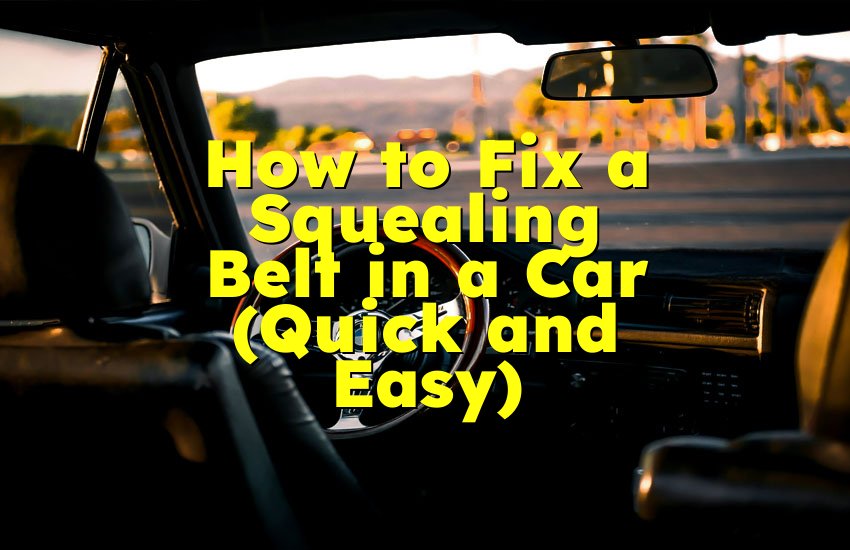As an Amazon Associate, I earn from qualifying purchases at no extra cost to you.
How to Safely Connect a Car Battery: Expert Guide
Connecting a car battery may seem simple, but doing it the wrong way can cause serious problems like sparks, electrical damage, or even injury. Whether you’re replacing a dead battery or just performing some maintenance, knowing the right way to connect your battery is crucial. In this guide, we’ll walk you through everything you need to know to connect your car battery safely, step by step. Let’s dive in!
Why Terminal Order Matters When Connecting a Car Battery
When you connect a car battery, it’s essential to follow the correct order for connecting the terminals. If done incorrectly, it can lead to electrical problems, sparks, or even a dangerous explosion.
The terminals on a car battery are marked with a ‘+’ for the positive terminal and a ‘–’ for the negative terminal. Most people think that the order in which you connect them doesn’t matter, but it does. If you don't connect them properly, you might cause a short circuit, which can harm the car’s electrical system. So why does terminal order matter? Let’s explore.
Understanding the Positive and Negative Terminals
Before connecting the battery, it’s important to understand the purpose of the positive and negative terminals. The positive terminal is where the power flows into the car’s electrical system. The negative terminal acts as a ground, completing the circuit.
If you accidentally connect the negative terminal first, you might create a path for electricity to flow in a way that could cause sparks or damage. The risk of a short circuit is higher when working with the negative terminal because it could connect with any nearby metal, including the car’s frame.
The Role of Grounding in the Process
Grounding plays a huge role in electrical circuits. By connecting the negative terminal last, you make sure you’re grounding the circuit properly. If you connect the negative terminal first, any metal parts of the car can act as an unintended ground, which could lead to sparks or other electrical issues. That’s why it's recommended to connect the positive terminal first and the negative last.
Positive or Negative: Which Terminal Should You Connect First?
Now that we understand why the order matters, let's break it down in simple steps. Which terminal should you connect first? The answer is the positive terminal. Always connect the positive terminal first. This simple step can save you a lot of headaches down the road.
Why You Should Always Start with the Positive Terminal
The positive terminal is typically marked with a red cover or cable, and it's connected to the car’s electrical system. By connecting it first, you’re ensuring that the circuit is “live” before touching the negative terminal. This is important because the negative terminal is connected to the vehicle's body, and touching it first could create a direct short circuit.
It's also safer to connect the positive terminal first because it reduces the chances of creating a spark. Since the negative terminal is grounded, connecting it first can cause unintended paths for the electrical current to flow.
Benefits of Connecting the Negative Terminal Last
Connecting the negative terminal last has its benefits as well. Once the positive terminal is connected, the vehicle's electrical system is "ready" for power. When the negative terminal is attached last, it completes the circuit safely without any risk of sparks or shorts. This method ensures that everything is connected properly, and it's much safer for you and your car.
Step-by-Step Guide to Connecting a Car Battery Safely
Now that you know why the terminal order is important, let’s go through a detailed, step-by-step guide on how to safely connect a car battery. Don't worry; it's much easier than it sounds! Just follow these simple steps, and you'll have your car up and running in no time.
Step 1: Gather Your Tools and Equipment
Before you start, make sure you have everything you need. Here's a quick list of what you'll need to get the job done safely:
- A new car battery (if you’re replacing the old one)
- A wrench or socket set
- Gloves (preferably rubber or latex gloves for safety)
- Safety glasses to protect your eyes
- A rag or towel to clean up any spills
- A battery terminal cleaning brush (optional, but useful)
- A flashlight (in case you're working in low light)
Step 2: Prepare the Vehicle and Battery Area
Before you start handling the battery, ensure that you're working in a safe and clear area. Start by turning off your vehicle and ensuring it’s in a secure location—preferably a well-lit area, away from any flammable materials. Make sure your car is parked on a flat surface. This step is essential because if the car is on an incline, it might be harder to access the battery or could lead to accidental spills.
Next, open the car's hood and locate the battery. Most vehicles have the battery in the front, near the engine, though some cars may have it in the trunk or under the seat. Once you've located the battery, carefully remove any covers that might be in place. Many cars have a protective plastic cover over the battery. Make sure to remove that before proceeding. Also, check if there's any debris or dirt around the battery that could interfere with your work. If necessary, use your rag to wipe away any dirt around the battery to keep things neat.
Once everything is visible and clear, it's time to move on to the next step. It's essential that you ensure the area is safe, as car batteries contain acid, and working in a cluttered or unsafe area can lead to accidents.
Step 3: Disconnect the Negative Terminal First
The first action you need to take when working with a car battery is disconnecting the negative terminal. This step is important because it minimizes the risk of a short circuit. The negative terminal is usually marked with a minus sign (“–”) and is often connected to the car’s metal frame or body, which acts as a ground.
Use your wrench or socket set to loosen the bolt securing the negative cable to the battery terminal. Be sure to loosen the nut or bolt gently to avoid stripping it. Once the bolt is loose, carefully pull the negative cable off the battery terminal. Be cautious not to let the cable touch any metal parts of the car once it's removed, as it could cause a short circuit. It’s a good practice to keep the cable away from the battery and any surrounding metal parts by tucking it to the side, out of the way.
The reason why you disconnect the negative terminal first is that the battery is still "live," meaning it can still provide power to the car's electrical system. By disconnecting the negative terminal, you're breaking the electrical connection and reducing the risk of electrical shock, sparks, or damage to your car's electrical components.
Step 4: Disconnect the Positive Terminal
Once the negative terminal is safely disconnected, it's time to work on the positive terminal. The positive terminal is marked with a plus sign (“+”) and is often red to distinguish it from the negative terminal.
Using the same wrench or socket set, loosen the nut or bolt securing the positive cable to the battery terminal. Again, be gentle to avoid damaging the bolt or the terminal. After loosening the bolt, carefully remove the positive cable from the terminal. Set the positive cable aside, making sure it doesn't touch any metal parts of the car. It's especially important to keep the positive cable away from the negative terminal, as they are connected to different sides of the electrical system and can cause sparks if they touch each other.
Now that both terminals are disconnected, the battery should be completely isolated from the car's electrical system. You've taken the necessary precautions to ensure that nothing will be damaged or spark while you work.
Step 5: Remove the Old Battery (If Replacing)
If you are replacing the old battery with a new one, you'll need to remove the old one carefully. Car batteries are heavy, so use both hands when lifting it. In some cars, the battery may be secured with a bracket or clamp, which you'll need to remove before you can take out the battery.
Use your wrench to remove any bolts or fasteners securing the battery in place. Once the fasteners are removed, carefully lift the battery out of the tray. It might be heavy, so be prepared for some effort. Set the old battery aside in a safe location—away from metal objects to avoid creating a short circuit. You can also take it to a recycling center, as car batteries contain materials that should not be disposed of in regular trash.
If you are simply disconnecting the battery for maintenance, skip this step and proceed with the installation of the new battery.
Step 6: Clean the Battery Terminals
Before installing a new battery, it's important to clean the battery terminals. Over time, corrosion can build up on the terminals, which can affect the connection and the performance of your car’s electrical system. Corrosion typically appears as a white, powdery substance around the battery terminals. If left untreated, corrosion can cause the battery cables to loosen or result in poor contact, preventing the car from starting properly.
Use a battery terminal cleaning brush to scrub away any corrosion on the terminals. If you don't have a specific cleaning brush, a wire brush or an old toothbrush can do the job. For a more thorough cleaning, mix a solution of baking soda and water (about 1 tablespoon of baking soda to 1 cup of water) and use it to clean the terminals. This will neutralize any acid that may have leaked from the battery.
Once the terminals are clean, use a rag to wipe them down and remove any leftover moisture or debris. Cleaning the terminals ensures a solid connection between the battery and the car's electrical system, which will help your car run smoothly after installation.
Step 7: Insert the New Battery
Now that the terminals are clean and free from corrosion, it's time to insert the new battery into the battery tray. Carefully lift the new battery and place it into the tray, ensuring that it fits securely in the space. Some batteries may come with a bracket or strap that helps hold the battery in place. If your new battery has a bracket, make sure to secure it properly with bolts or fasteners to prevent the battery from moving.
Double-check that the battery is aligned correctly, with the positive and negative terminals on the appropriate sides. This will ensure that you don't mix up the cables when reconnecting the terminals.
Step 8: Connect the Positive Terminal First
It's time to reconnect the battery cables. Start with the positive terminal. Take the positive cable and attach it to the positive terminal of the battery. Use your wrench to tighten the nut or bolt, making sure the cable is firmly connected to the terminal. Don't over-tighten it, but make sure it's snug to avoid any loose connections.
Connecting the positive terminal first is important because it allows you to safely complete the electrical circuit. Since the negative terminal is grounded, connecting it last reduces the risk of sparks or electrical shorts.
Step 9: Connect the Negative Terminal Last
Once the positive terminal is securely connected, proceed to the negative terminal. Attach the negative cable to the negative terminal and tighten the nut or bolt with your wrench. Again, ensure that it's tight enough to prevent it from coming loose but not so tight that it damages the terminal.
By connecting the negative terminal last, you ensure that the electrical circuit is grounded properly. This reduces the risk of sparks or other electrical issues.
Step 10: Test the Connection
Once both terminals are connected, give them a quick check. Ensure that both cables are tight and secure on the battery terminals. If either cable feels loose, tighten it a bit more until it's firmly in place.
Now, it's time to test your work. Start your car and see if it turns on without any issues. If the car starts smoothly, congratulations! You’ve successfully connected your car battery. If the car doesn't start, double-check the connections to make sure everything is secure and properly connected.
Common Mistakes to Avoid When Connecting a Car Battery
Connecting a car battery is a simple process, but there are common mistakes that many people make. Avoiding these can help you keep your car in good condition and ensure safety.
Mistake #1: Connecting the Negative Terminal First
As we've already discussed, connecting the negative terminal first can cause sparks, short circuits, and other issues. Always connect the positive terminal first, followed by the negative terminal.
Mistake #2: Over-tightening the Battery Terminals
While it's important to ensure the terminals are tight, over-tightening can damage the battery or the terminal itself. Tighten them just enough to secure the cable without going too far.
Mistake #3: Ignoring Battery Corrosion
If you notice that your battery terminals are corroded, don't ignore it. Corrosion can create poor connections and lead to starting issues. Always clean the terminals before installing a new battery.
Mistake #4: Not Wearing Safety Gear
Battery acid is dangerous and can cause harm to your skin and eyes. Always wear gloves and safety glasses when handling the battery.
Mistake #5: Not Using the Right Tools
Using the wrong size wrench or socket can make the process difficult or even cause damage to the terminals. Make sure you have the proper tools for the job.
I hope this article helped you understand how to safely connect a car battery and why the order of connections is so important. By following these simple steps, you can ensure that you're doing the job safely and correctly. If you need to replace your car battery or simply maintain it, this guide will help you get it done without a hitch.
Frequently Asked Questions
Is it safe to connect a car battery if I’m not an expert?
Connecting a car battery isn't very difficult, but safety is key. As long as you follow the proper steps and take your time, it's safe to do yourself. If you’re unsure, ask a professional to help.
Can I use any car battery for my vehicle?
No, it’s important to use a battery that matches your vehicle's specifications. Always check your owner's manual or consult with a mechanic to ensure you’re getting the right battery for your car.
Do I need to replace both battery terminals when replacing a battery?
Typically, you don't need to replace the terminals unless they're damaged or corroded. If they're still in good condition, you can keep using them, but make sure they're clean and secure.
Is it safe to connect a car battery while the car is on?
It's not safe to connect a car battery while the car is on. Always make sure the car is turned off before connecting the battery to avoid electrical issues or sparks.
Can I connect a car battery in the rain?
It’s not ideal to connect a car battery in the rain. Water can increase the risk of electrical shorts. If possible, wait for dry weather or work in a sheltered area.
Do I need to disconnect the battery when replacing car parts?
Yes, it's a good idea to disconnect the battery when working on car parts that might affect the electrical system. This helps prevent accidental electrical issues or shocks.
Is it safe to jump-start a car with a damaged battery?
Jump-starting a car with a damaged battery can be risky. If the battery is severely damaged or leaking, it's better to replace it before attempting to jump-start the car.
Can I use household tools to connect a car battery?
It's best to use automotive tools like a wrench or socket set when connecting a car battery. Household tools might not fit the terminals properly or could cause damage.











